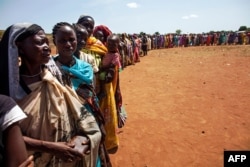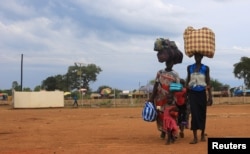U.N. aid agencies warn the humanitarian crisis in South Sudan, already one of the biggest in the world, is getting worse as famine looms and growing numbers of refugees flee to neighboring countries.
The World Food Program reports a 38-truck convoy, carrying food for about one month, arrived in the South Sudanese town of Yei on Friday. The agency says the food and other relief supplies will be a life-saver for thousands of families who have been trapped in the area for four months because of fighting and insecurity.
WFP spokeswoman Bettina Luescher says thousands of people in Yei and throughout South Sudan are fleeing intensified violence that stems from the country’s nearly three-year conflict. She says they have been forced to leave their crops to rot in the field, adding to a growing problem of hunger.
“Up to four million people, a third of the population in South Sudan are severely food insecure—meaning a third of the country does not know where the next meal is coming from," said Luescher. "The malnutrition is above emergency levels in seven of the 10 states, nearly twice of the emergency threshold in two states. We are very concerned that the threat of famine is very real, that it could happen.”
Luescher says humanitarian agencies have helped to stave off catastrophe so far. But, she says funds to carry out life-saving operations are running out. She says WFP urgently needs $113 million for operations through January.
In the meantime, the United Nations refugee agency reports the number of people fleeing South Sudan continues to grow. Last month, it says, an average of 3,500 people fled to neighboring countries each day.
UNHCR spokeswoman Cecile Pouilly says nine out of 10 refugees are women and children, with most of the outflow, around 2,400 per day, arriving in Uganda.
“Most of the arrivals are from Equatoria regions and they report armed groups harassing civilians, killings, torturing people suspected of supporting opposition factions, burning villages and sexually abusing women and girls,” said Poully.
In recent weeks, says Pouilly, refugees have increasingly used informal border crossing points, reportedly because armed groups are preventing them from using main roads. She says many have been forced to walk through the bush for days without food or water.
The UNHCR says it is scaling up its operations in Uganda and in the other countries of asylum - Ethiopia, Sudan, and the Democratic Republic of Congo - to keep pace with the growing refugee exodus from South Sudan.







